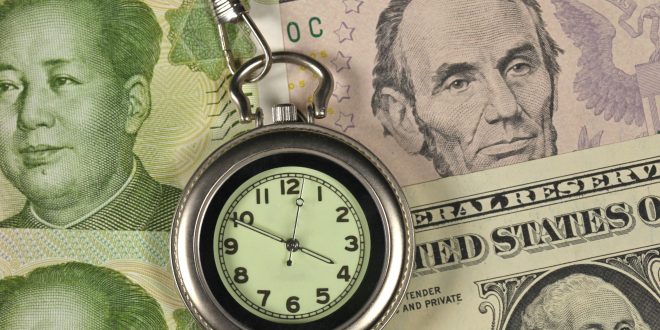A surge in the consumer price index (CPI) in the United States, the highest for the inflation rate in more than 12 years, was the highlight of the second week of May, as it raised question markets about whether the Federal Reserve would consider raising interest rates sooner than previously estimated.
Recent remarks by the Fed officials anticipated a short-lived surge in consumer prices before cooling during the second half of the year and in 2022, reflecting the promised patience in dealing with changed in the monetary policy until the economy fully recovers from the coronavirus pandemic.
The President of the Federal Reserve Bank of Philadelphia, Patrick Harker, said that the U.S. economy needs more time to recover before reducing the current pace of asset purchases, while Governor Lael Brainard said that the U.S. economy is recovering but remains challenged by uncertainty, reiterating the need for patience in monetary policy.
Markets will await the release of the Fed’s latest meeting minutes, looking for signs about the future direction of monetary policy decision in the U.S.
Economic Data
Retail sales in the United States were unexpectedly flat in April, as support ebbed from stimulus payments, but the coming months are likely to see an acceleration as savings reach unprecedented levels and economic activity resumes.
Moreover, the Retail Sales Control Group declined by 1.5% after rising 10.7% in March. Total sales for February 2021 through April 2021 period were up 27.1% from the same period a year ago. Economists polled by Reuters had expected retail sales to rise 1%.
Business inventories in the United States increased during March, official data by the Department of Commerce showed on Friday. The increase in inventories in March was relatively limited due to raw materials shortage that impacted production across some sectors.
In March, business inventories leveled up by 0.3% with the reading meeting market expectations. The reading follows a 0.6% rise in February, and shows that it remained unchanged on an annual basis.
Meanwhile, retail inventories declined by 1.4%, after increasing by 0.1% in February. The inventories of motor vehicles dropped by 6.1%, with the supply chain disruptions and an international shortage of semiconductors affecting production.
Aside from the auto sector, other retail inventories that are counted in the calculation of the gross domestic product (GDP) rose by 0.6%, meeting initial estimates. It is worth noting that in March wholesale inventories increased by 1.3%.
Industrial Production in the United States expanded by 0.7% on a monthly basis in April, according to data by the Federal Reserve. This reading followed March’s increase of 2.4%, revised from 1.4%, and fell short of analysts’ estimate of 1%.
Moreover, consumer confidence the United States declined in the early days of the month due to the rise in the inflation rate, according to data by the University of Michigan released on Friday.
The Consumer Sentiment Index rose decreased by 6.2% to 82.8 from 88.3 in April, but rose by 14.5% on an annual basis from its level at 72.3 in May 2020, supported by the recovery from the coronavirus pandemic.
The Current Economic Conditions gauge also fell by 6.6% to 90.8 in May from 97.2 in the previous month, but increased by 10.3% on an annual basis compared with a reading of 82.3 in the corresponding month of last year.
Meanwhile, the Index of Consumer Expectations fell by 6.2% to 77.6 from 82.7 in April, but on a yearly basis gained 17.8% compared with a reading of 65.9 in the same month of the previous year.
Rising inflation led to weaker expectations for real income, reaching their lowest level in five years.
USD
Recent fluctuations meant that the U.S. Dollar (USD) remained nearly unchanged for the week, following a strong drop by the end of the previous week.
The Dollar Index (DXY), which measures the greenback’s performance against a basket of six major international currencies, finished the week at 90.30, compared with its level by the end of the previous week at 90.23.
Markets will be anticipating in the coming week whether the President of the United States, Joe Biden, will succeed in reaching a bipartisan agreement with the Republican Party about his plans for massive spending on infrastructure and job creation.
The White House expressed willingness to compromise to reach a common ground, following objections from the conservatives about the increased level of spending, following the $1.9 trillion relief package.
Euro
Despite the recent surge of the European currency by the end of the week, on the back of a decline by the USD, the Euro (EUR) failed to achieve weekly gains against the greenback.
The EUR/USD pair finished the week lower by about 0.21% at 1.2141.
Latest data showed that investor sentiment in the Eurozone improved much more than expected in May. The gauge came in at 21.0 in May from -13.1 in April vs. an expected reading of 14.0.
In the Eurozone, expectations rose to +36.8 points, all-time high, so the European common currency got a fresh boost from optimistic data.
Meanwhile, the European Central Bank (ECB) Chief Economist, Philippe Lin, told a French newspaper that the ECB could still increase bond purchases at its June meeting, if such a step is needed to maintain favorable borrowing conditions.
He also added that unemployment is not expected to return to its pre-pandemic level before 2023, a long process that requires a sustained effort from both the central bank and European governments.
Gold
Gold prices recovered some ground on Friday, as the U.S. Dollar (USD) declined, further increasing their second consecutive weekly gains. Accordingly, the yellow metal futures managed to finish the week at their best level in about three months.
It is worth noting that a recent surge in Treasury bond yields, due to fears about the rise in the U.S. consumer inflation rate, limited gold’s weekly rise.
Gold futures for June delivery finished the week higher by 0.4%. at the highest closing level for gold’s most active contracts since February 10.
Meanwhile, silver futures for July delivery failed to recover from their 0.4% weekly loss.
Oil
Brent crude futures for July delivery recovered from the recent decline and turned to weekly gains of 0.6%, while the U.S. West Texas Intermediate (WTI) June futures rose by 0.7% on a weekly basis.
A recent downstream disruption in the United States that resulted from a cyberattack on the Colonial Pipeline, which led to fears about a drop in the demand for crude oil by refineries, appears to be at its end as the pipeline reopened on Wednesday.
The pipeline network provides nearly half of the gasoline supplies in the U.S. East Coast.
The number of active rigs drilling for crude oil and natural gas in the United States rose by five to 453 during the week, according to data by Baker Hughes on Friday.
The weekly report indicated that the oil rig count increased by eight to 352 this week, as natural gas rigs decreased by three.
European Stocks
European stocks surged on Friday, strongly rebounding from recent losses that resulted from a sell-off wave, as fears about the rise in the U.S. inflation rate eased.
The STOXX Europe 600 index gained 1.2% on Friday to finish at 442.55 points, but remained down for the week by about 0.5%, with the auto sector leading the gains by adding 1.9%, while the basic sources sector was the sole decliner by losing 1%.
Wall Street
The New York Stock Exchange (NYSE) surged on Friday, rebounding from recent losses that resulted from concerns among Wall Street investors about the rise in inflation, amid an improvement in risk sentiment.
However, the main indices failed to recover all of their recent losses and finished the week with the worst performance in about three months.
The S&P 500 dropped 1.4%, after registering its biggest daily rise since March 26 in the last session of the week.
The Nasdaq Composite also recorded its highest daily gain rise in about two months but finished the week lower by 2.3%
Cryptocurrencies
Bitcoin lost roughly 13% for the week after Tesla, a major support and investor in the biggest digital currency in terms of market cap, decided that it will no longer accept the cryptocurrency as payment for its electric cars and other products due to concerns about the carbon footprint of Bitcoin mining.
In addition, reports about an investigation of crypto exchange Binance further increased the concerns about digital currencies.
 Noor Trends News, Technical Analysis, Educational Tools and Recommendations
Noor Trends News, Technical Analysis, Educational Tools and Recommendations





